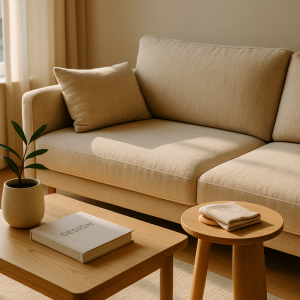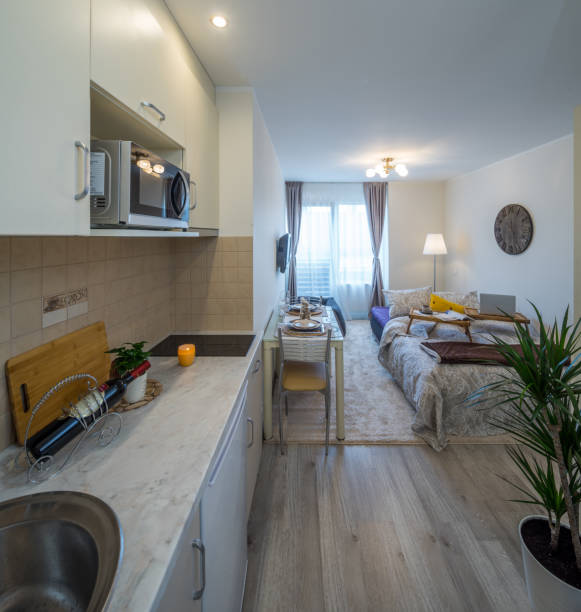 Design is often credited for its shape, color, and texture. We admire the curve of a chair, the tone of a rug, or the light bouncing off polished concrete. But one element rarely discussed, though it affects all the others, is cleanliness. Not the sterile, soulless kind, but the quiet, consistent care that keeps a space feeling alive. In modern interiors, upholstery cleanliness — often maintained through expert couch cleaning Sunshine Coast services — is one of the most underestimated design factors.
Design is often credited for its shape, color, and texture. We admire the curve of a chair, the tone of a rug, or the light bouncing off polished concrete. But one element rarely discussed, though it affects all the others, is cleanliness. Not the sterile, soulless kind, but the quiet, consistent care that keeps a space feeling alive. In modern interiors, upholstery cleanliness — often maintained through expert couch cleaning Sunshine Coast services — is one of the most underestimated design factors.
We talk endlessly about fabric selection —whether linen, velvet, or boucle —but what happens after the sofa arrives is equally essential. Dust, oils, and everyday wear slowly mute the fabric’s color, flatten its fibers, and dull the room’s overall mood. Over time, neglect doesn’t just affect hygiene; it changes the design itself.
The Silent Influence of Cleanliness
Most interiors are designed with intention: light sources are chosen for their warmth, layouts for their flow, colors for their emotion. But that intent fades when a layer of grime settles into fabric. What was once crisp and inviting starts to look tired.
Cleanliness affects how light interacts with a surface. Dust scatters light unevenly, altering how textures read in the space. A velvet sofa that once reflected light in soft gradients starts absorbing it, appearing flat. A pale armchair begins to yellow slightly, throwing off the color palette of an otherwise balanced room. These are subtle shifts, but together they create a quiet dissonance, a sense that something feels off, even if you can’t say what.
A well-kept interior, on the other hand, maintains visual harmony. Colors stay true. Textures stay dimensional. The design continues to communicate what it was meant to: warmth, sophistication, ease. In that sense, cleanliness isn’t just maintenance; it’s part of the design language.
Upholstery as the Emotional Anchor
Upholstered furniture carries emotional weight in a room. It’s where people sit, talk, read, nap, and spill coffee. It’s both an aesthetic centerpiece and a human touchpoint. So when upholstery looks unkempt, the entire space feels neglected. Even minimal dust or discoloration can undermine the atmosphere of calm or luxury that the design intends to create.
That’s because people read cleanliness instinctively. You don’t consciously analyze whether a sofa has been vacuumed recently. You sense comfort or unease. Cleanliness, then, is not only visual but psychological. It affects how welcome and relaxed people feel.
For designers, this is an overlooked opportunity. Integrating upholstery care into the design process reinforces the longevity and integrity of the space. It ensures that months or years after installation, the space still looks and feels as intended.
Cleanliness and Material Longevity
Designers often talk about sustainability, but sustainability isn’t only about materials and sourcing. It’s also about preservation. Each fabric has its own chemistry. Natural fibers like cotton and wool absorb oils and odors; synthetics like polyester resist stains but can trap dust within their weave. Regular professional cleaning, or even thoughtful at-home maintenance, prevents buildup that breaks down fibers. Over time, that care maintains the piece’s structure, color, and tactile quality.
From a sustainability standpoint, this matters more than most realize. A sofa that lasts fifteen years because it’s well cared for has half the environmental footprint of one that’s replaced every seven. In this way, cleanliness becomes an ethical design choice, aligning with modern values of stewardship and responsible consumption.
The Aesthetic of Clean Design
Minimalist interiors often emphasize clean lines and uncluttered surfaces, but actual clean design goes deeper than visual simplicity. It includes actual cleanliness: air that feels fresh, fabrics that feel cared for, and spaces that look effortlessly maintained.
This is especially important in modern open-plan living, where furniture is both functional and sculptural. Upholstered pieces act as color anchors or textural contrast against harder materials like metal, glass, or stone. When they lose their crispness, the visual balance collapses. The room starts to feel heavy or stale, even when everything is technically in place.
Professional designers know that styling and maintenance go hand in hand. They often recommend protective fabric treatments, regular vacuuming with soft brushes, and periodic deep cleaning. Some even plan upholstery color schemes based on ease of care, choosing mid-tones that hide minor wear while still brightening the room.
Cleanliness as a Design Ethic
Suppose you think about the interiors that truly endure —those that age gracefully —they all share one quality: consistent care. The patina of a leather armchair, the brightness of a neutral sofa after years of use, the freshness of drapery that still moves softly with light—these things are not accidents. They’re the result of care treated as an extension of design.
Designers often describe their goal as creating spaces that feel lived in but not worn out. That balance is achieved not by styling alone but by maintenance. Upholstery care, in particular, bridges that gap between visual beauty and lived experience.
In high-end hospitality design, for example, upholstery care is built into the operations manual. Hotels understand that the tactile experience of a chair or banquette defines the guest’s perception of quality. The same principle applies at home. Clean, cared-for upholstery signals refinement, not because it’s new, but because it’s respected.
Redefining What Counts as Design
It’s time to broaden the definition of design to include cleanliness as an aesthetic and functional discipline. After all, what is design if not the ongoing curation of a space’s sensory experience? Cleanliness shapes how we see, touch, and even breathe in a room.
When we start viewing upholstery care as part of design, not an afterthought, we elevate both the object and the environment. The sofa becomes more than a purchase; it becomes a relationship. The space becomes more than decorated; it becomes alive.
Ultimately, cleanliness is not about perfection. It’s about preservation, of intention, of material, of atmosphere. The best-designed interiors don’t just look good when they’re finished. They keep looking good because someone cared enough to keep them that way.



 Design is often credited for its shape, color, and texture. We admire the curve of a chair, the tone of a rug, or the light bouncing off polished concrete. But one element rarely discussed, though it affects all the others, is cleanliness. Not the sterile, soulless kind, but the quiet, consistent care that keeps a space feeling alive. In modern interiors, upholstery cleanliness — often maintained through expert couch cleaning Sunshine Coast services — is one of the most underestimated design factors.
Design is often credited for its shape, color, and texture. We admire the curve of a chair, the tone of a rug, or the light bouncing off polished concrete. But one element rarely discussed, though it affects all the others, is cleanliness. Not the sterile, soulless kind, but the quiet, consistent care that keeps a space feeling alive. In modern interiors, upholstery cleanliness — often maintained through expert couch cleaning Sunshine Coast services — is one of the most underestimated design factors. To be truly inclusive, technology must not feel like an afterthought. From the very beginning of the design process, architects and designers are including smart technologies to guarantee:
To be truly inclusive, technology must not feel like an afterthought. From the very beginning of the design process, architects and designers are including smart technologies to guarantee: Jeju Island boasts some of South Korea’s most captivating nightlife spots. These exclusive lounges draw visitors with their blend of elegance and innovation. Picture stepping into spaces where soft lights dance across polished surfaces, creating an inviting glow. Modern lines intersect with hints of ancient Korean charm, turning ordinary evenings into memorable escapes. As the sun sets over volcanic landscapes, these venues come alive, offering a fresh take on entertainment.
Jeju Island boasts some of South Korea’s most captivating nightlife spots. These exclusive lounges draw visitors with their blend of elegance and innovation. Picture stepping into spaces where soft lights dance across polished surfaces, creating an inviting glow. Modern lines intersect with hints of ancient Korean charm, turning ordinary evenings into memorable escapes. As the sun sets over volcanic landscapes, these venues come alive, offering a fresh take on entertainment. Architects and designers are constantly searching for tools that balance creativity with precision. Whether you’re sketching a concept for a sustainable home or rendering a futuristic skyline, the right resources can make all the difference. But with so many platforms and tools available, finding safe, verified links can feel like navigating a maze. That’s where curated lists come in—offering clarity, credibility, and inspiration.
Architects and designers are constantly searching for tools that balance creativity with precision. Whether you’re sketching a concept for a sustainable home or rendering a futuristic skyline, the right resources can make all the difference. But with so many platforms and tools available, finding safe, verified links can feel like navigating a maze. That’s where curated lists come in—offering clarity, credibility, and inspiration. When it comes to building a new home, architecture and design play a big role in turning a dream into a reality. A well-designed home by maykus.com/southlake/ doesn’t just look good—it also works better for daily living. From the way sunlight enters a room to how a space connects with nature, good design brings comfort, function, and beauty together.
When it comes to building a new home, architecture and design play a big role in turning a dream into a reality. A well-designed home by maykus.com/southlake/ doesn’t just look good—it also works better for daily living. From the way sunlight enters a room to how a space connects with nature, good design brings comfort, function, and beauty together. Starting the healing process with the patient experience, reduced noise levels, lots of natural light, access to nature or soothing views, and design features all greatly affect patient comfort and help to lower anxiety. Less stressful experiences result from thoughtful wayfinding, clear signage, and cozy waiting rooms. Private rooms with separate controls over temperature and lighting improve patient autonomy and rest—qualities essential for rehabilitation.
Starting the healing process with the patient experience, reduced noise levels, lots of natural light, access to nature or soothing views, and design features all greatly affect patient comfort and help to lower anxiety. Less stressful experiences result from thoughtful wayfinding, clear signage, and cozy waiting rooms. Private rooms with separate controls over temperature and lighting improve patient autonomy and rest—qualities essential for rehabilitation.
 Flexible and Convenient
Flexible and Convenient Vaulted ceilings necessitate more intricate framing and a greater quantity of materials. Furthermore, lighting and fixtures may be more challenging to install.
Vaulted ceilings necessitate more intricate framing and a greater quantity of materials. Furthermore, lighting and fixtures may be more challenging to install.














 hinese Numerology and its relation to urban
hinese Numerology and its relation to urban  House Number 6 – This house is perfect for large families needing to maintain harmony. Still, whether large or small, families benefit from the vibrations promoting nurturing, equality and instilling a sense of belonging to each house member.
House Number 6 – This house is perfect for large families needing to maintain harmony. Still, whether large or small, families benefit from the vibrations promoting nurturing, equality and instilling a sense of belonging to each house member.









 In architecture and interior design, every detail counts—from lighting to furniture layout. One detail that often gets overlooked is how cleanliness, especially carpet care, impacts the overall look and feel of a space. While design choices may focus on color, form, and function, they should also consider how easy a space is to maintain and a PRO Carpet Cleaning Sunshine Coast. Clean carpets don’t just make a room look better—they help preserve your design choices over time.
In architecture and interior design, every detail counts—from lighting to furniture layout. One detail that often gets overlooked is how cleanliness, especially carpet care, impacts the overall look and feel of a space. While design choices may focus on color, form, and function, they should also consider how easy a space is to maintain and a PRO Carpet Cleaning Sunshine Coast. Clean carpets don’t just make a room look better—they help preserve your design choices over time.
 Modern buildings are designed with sustainability at their core, integrating advanced systems like LED lighting, HVAC, and smart technologies to optimize energy use and minimize waste. While these technologies are revolutionary, their full potential depends on consistent and effective preventative maintenance to ensure efficiency and longevity.
Modern buildings are designed with sustainability at their core, integrating advanced systems like LED lighting, HVAC, and smart technologies to optimize energy use and minimize waste. While these technologies are revolutionary, their full potential depends on consistent and effective preventative maintenance to ensure efficiency and longevity.


